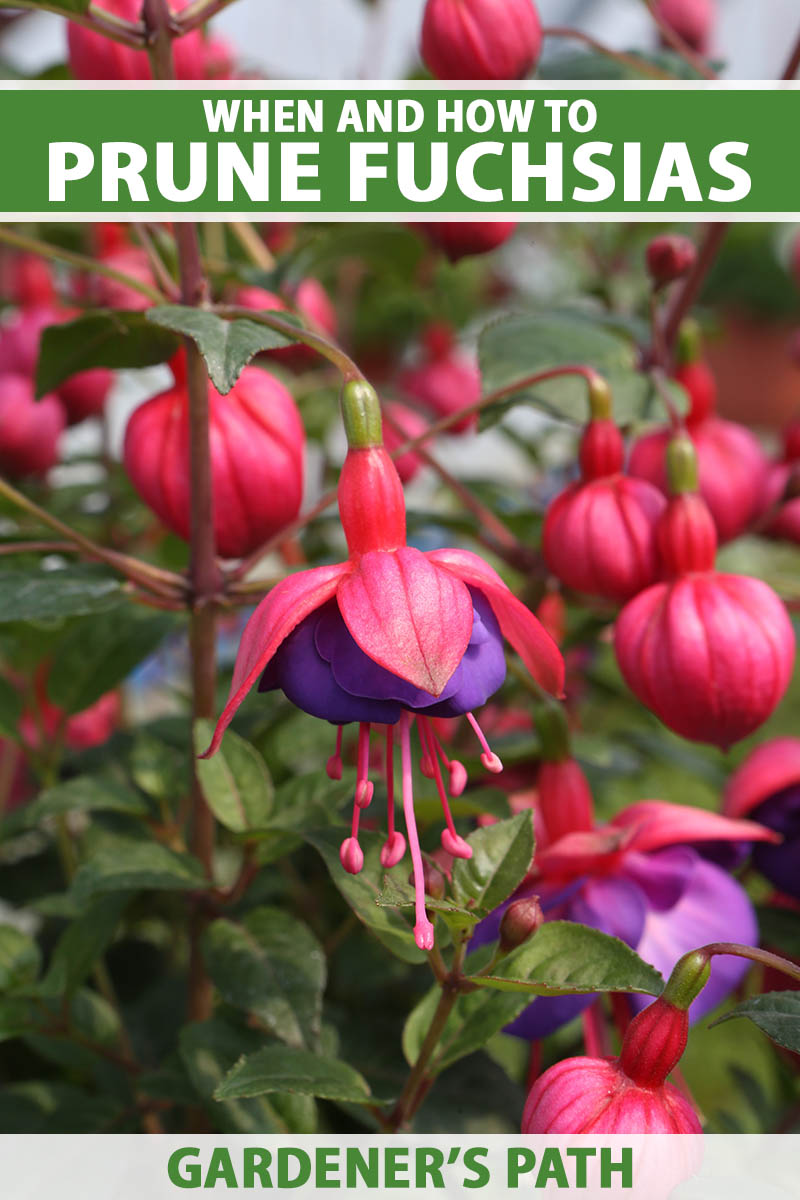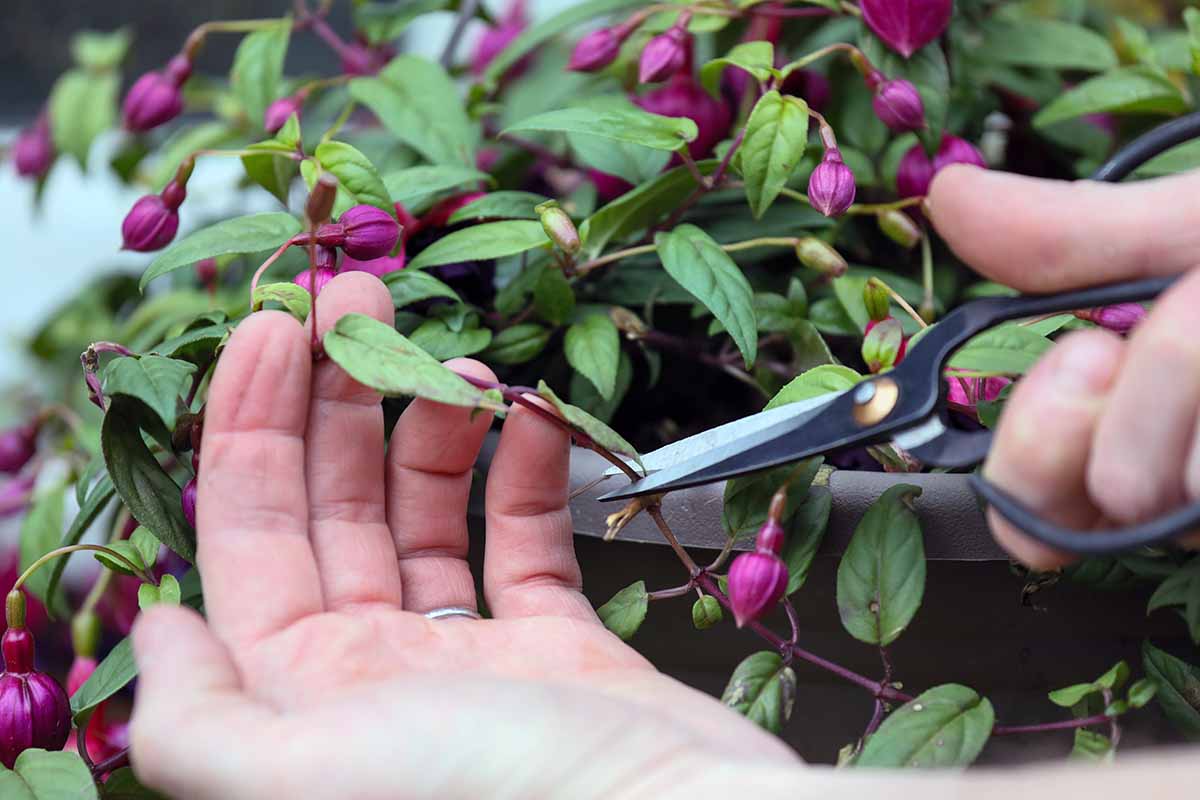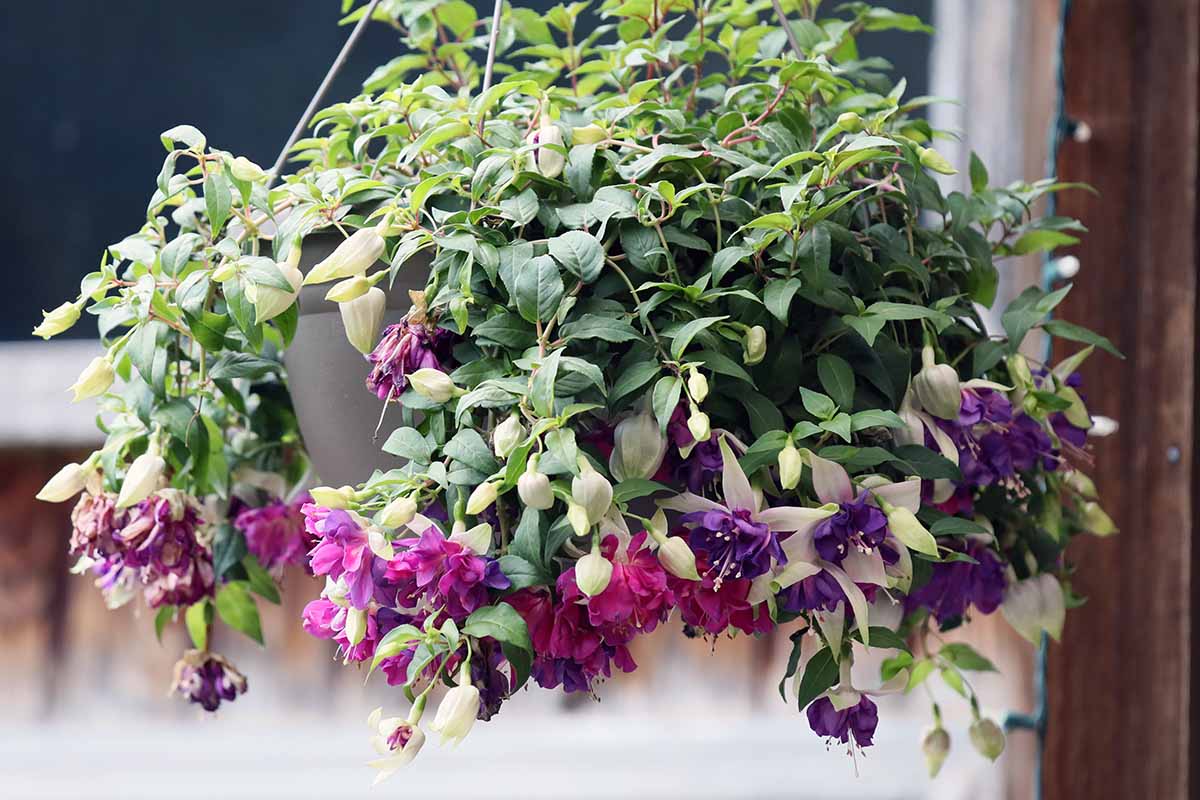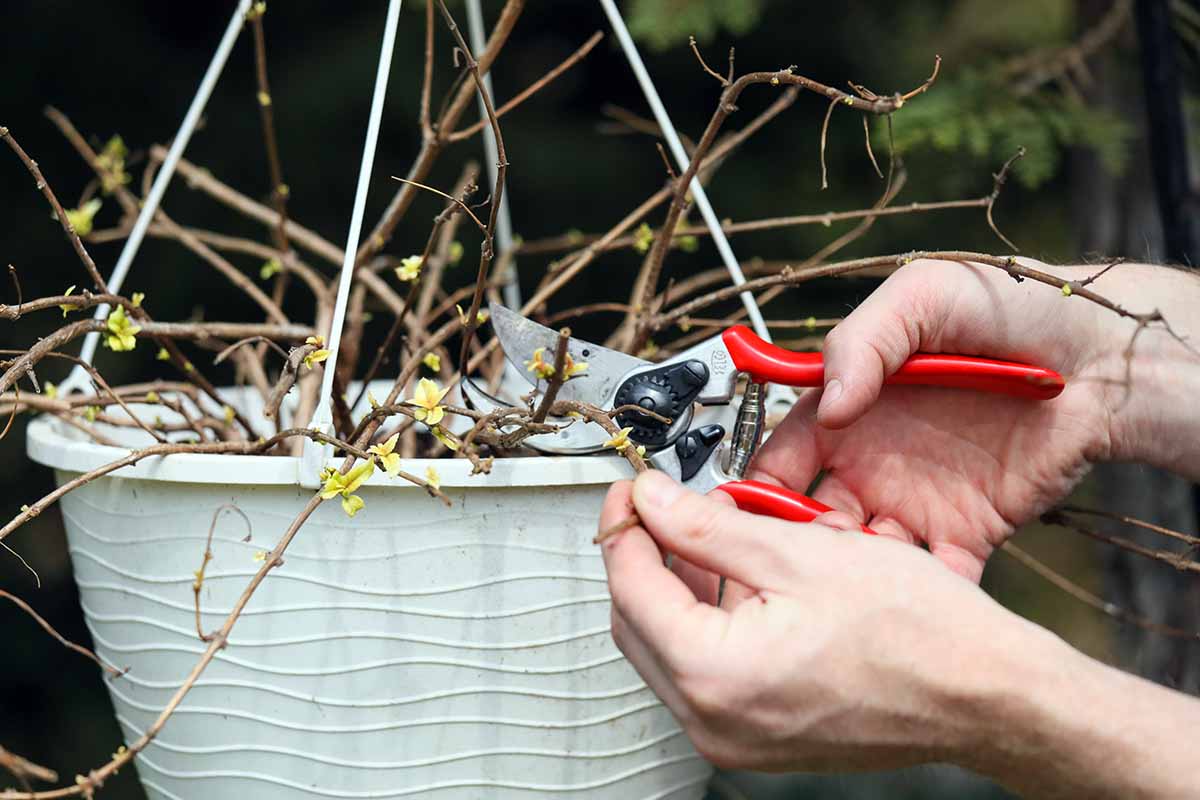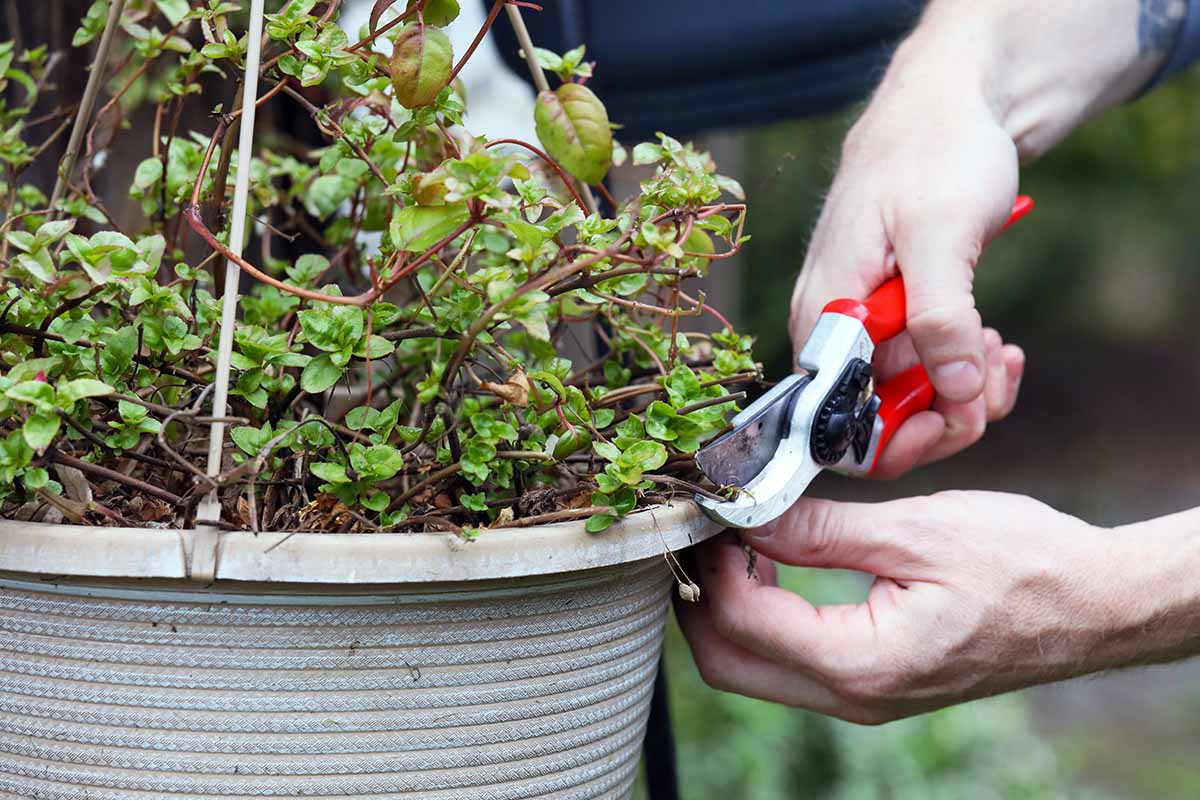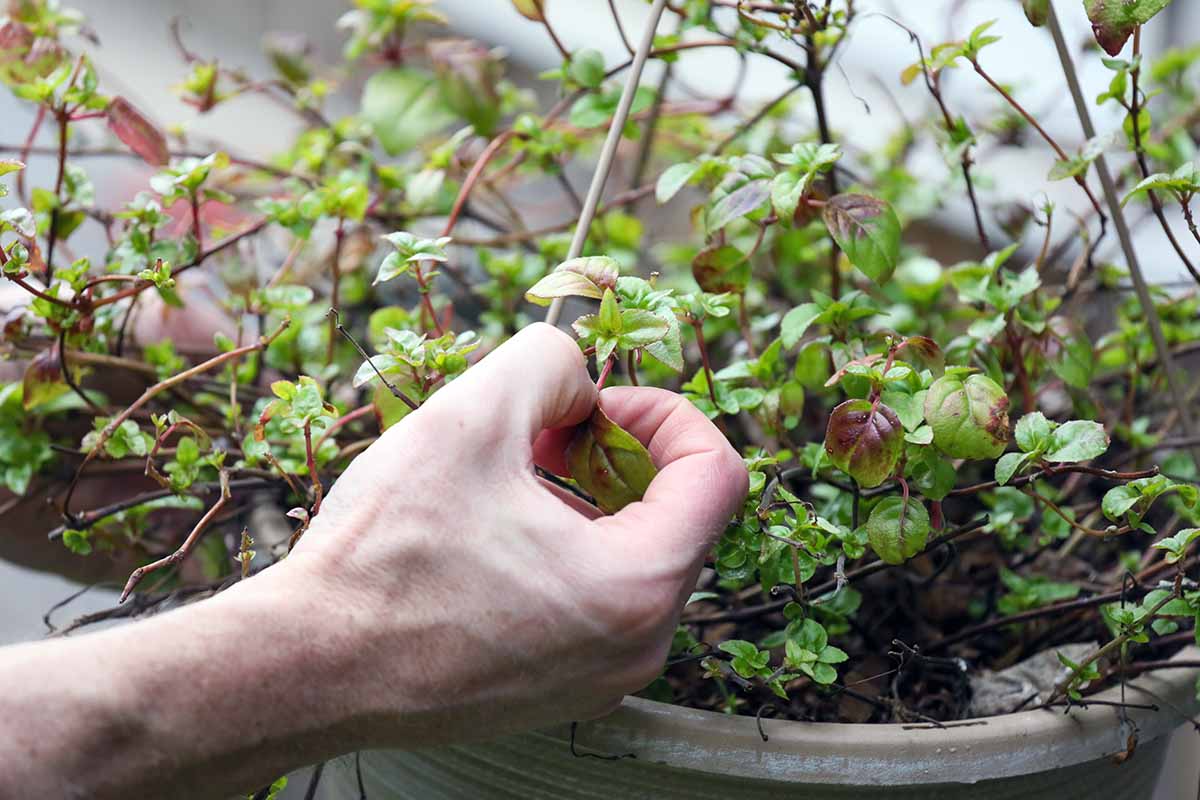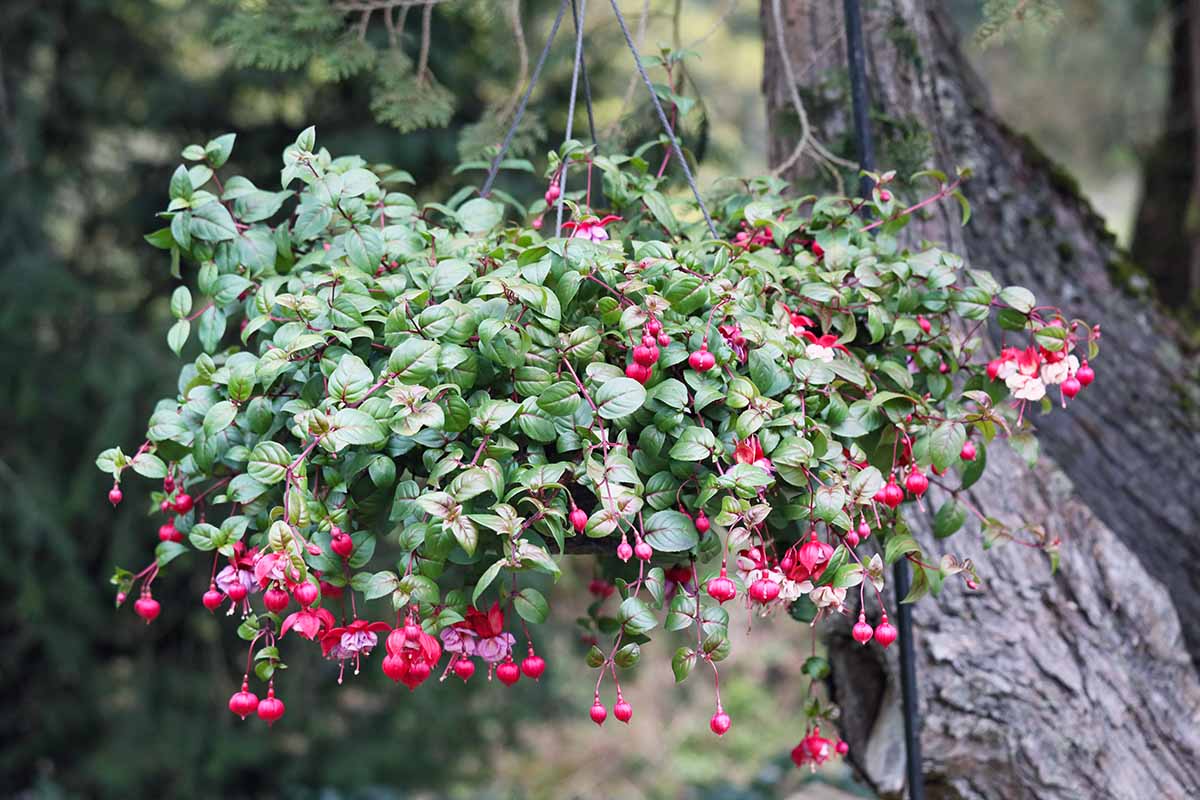Having said that, you don’t just want to head out with the snips and go all Edward Scissorhands on your shrub. You might produce an interesting topiary, but you probably won’t see the floral display you’re hoping for. Then again, fuchsias are so forgiving, you just might. We link to vendors to help you find relevant products. If you buy from one of our links, we may earn a commission. If you’re ready to learn how, here’s what we’ll go over in the coming guide: If you just keep your fuchsias for a season and toss them out, you have a different job ahead than if you overwinter or grow them as perennials. If you grow these pretty plants as annuals, all you really need to worry about is deadheading, which we’ll touch on towards the end of this guide. If you’re looking for advice on shaping fuchsia as bonsai, head to our bonsai pruning guide instead. Pruning requires a pair of scissors or secateurs, depending on how thick the branches are, of course. Other than that, you just need some muscle and time.
Why Prune?
The purpose of pruning is two-fold. First, you’re giving the plant some shape. Second, it encourages bountiful blossoms. If you were to leave your specimen completely untrimmed, it wouldn’t bloom as well as it could otherwise. Fuchsias produce blossoms at the tip of the stem. The more tips you have, the more flowers you’ll have. Those big, beautiful hanging baskets you see at stores in the spring? They’ve been carefully pruned to maximize the number of tips, and consequently, flowers. In other words, don’t neglect your pruning. Also, don’t be afraid to go hard. Fuchsias respond well to trimming and you can remove half or more of the branches without harming it. In fact, it will be happier for it. During the growing season, you can cut back by a third to encourage new growth and more blossoms.
When to Prune
The best time to prune is in the spring or late winter. You can pinch back or remove damaged or diseased stems all year long, but reserve the real pruning for the springtime, ideally when the plant is just starting to form leaf buds. If you don’t experience freezes during the spring, feel free to trim a hardy type any time when the plant is dormant. If you do have freezes in your area, don’t trim until the last projected frost date. It won’t kill the plant if you experience a freeze after you prune, but it’s not ideal. The earlier you prune, the sooner you’ll see blossoms. You don’t need to worry that doing so will reduce blossoming as it can for some species like hydrangeas. No matter when you prune, it will continue growing and blooming. That’s one of the fantastic things about fuchsias. The only exception to this is in the case of seedlings. We’ll discuss that in a bit.
Upright Fuchsias
If this is what you’re growing, start by removing any weak, crossing, or spindly branches. Next, trim off any branch that doesn’t have any growth on it. It might just be slower to emerge than other branches that are nearby, but we don’t want to preserve any underachievers on our plants. Finally, cut back all of the branches to an even length to give your plant a tidy shape of your choosing. The shape itself is up to you. Just follow the natural growth habit of the fuchsia, whether it’s a columnar, tree, low-growing, or bushy type. If you’re pruning as a standard, remove any growth from the part of the stem that you want to leave bare.
Trailing or Hanging Types
Those growing in hanging baskets require a slightly different approach. Your goal is to encourage the center to produce new, bushy growth. Prune as described above for an upright fuchsia, but leave as much of the stems in the center intact as possible. Cut these back to about six inches long to encourage branching, but don’t remove them unless they’re dead or diseased. In the fall, if you bring your plants indoors to overwinter, prune the branches back to the inside rim of the pot once again.
Reviving Fuchsias
Sometimes a hardy or tender fuchsia needs more than just a standard pruning, to help revive a specimen that has become leggy or one that struggled during the winter. This should be done in the spring, before or just as the leaves are starting to develop. I overwinter my tender plants in my basement, and when I pull them out again, they look less than ideal. But with some heavy pruning, they’re back to looking perfect in no time at all. Before you start, spray the plant with warm water every day for about a week to encourage the buds to form and for it to emerge from dormancy. The next step is to remove any dead branches or leaves that stuck around through the winter. If the plant hasn’t started forming leaves yet, just test each branch by gently bending it. If it bends but feels resilient and doesn’t break, leave it. If it snaps or feels dry, remove it. Next, cut every single branch back to just inside the pot rim, except for the ones at the top that are coming out of the center of the plant. Finally, trim the top, central stems back to about six inches. Again, you don’t need to worry about cutting back to a node. Isn’t that great?
Pruning Young Plants
Many times we buy an already-pruned, heavily blooming specimen. But specialty nurseries often sell little seedlings that only have a branch or two. These should be pruned multiple times throughout the year to encourage bushy growth. Trailing types should be pruned right away. Cut all the stems back so they are about four inches long. Your goal is to provide a little shape and encourage branching. After a few weeks or months, the stems should have branched and grown a few more inches. At this point, your job is to simply pinch back the growing tips to encourage branching. For upright types, leave them alone for a month or so, and allow them to develop a little. Now it’s time to provide a little shape and pinch back the growing tips. You don’t need to remove length at this point, just encourage branching. Allow the plant to continue growing, but pinch the growing tips back every few weeks. After the first year, you can treat your new additions as you would any other mature fuchsia.
Deadheading
Deadheading is a part of pruning, though it is different from that early-season shaping prune. There are two methods of deadheading. You can deadhead individual blossoms as they fade, using your fingers or a sharp, clean pair of scissors. Snip behind the developing berry as far back as you want before you hit the next set of leaves. You can also cut back the entire plant or a large portion of stems by a third or a quarter to encourage bushier growth and new blossoms. Leave at least two leaf nodes on each branch. With the latter method, don’t do this during the hot days of summer. That’s sure to be too much stress for the poor thing. Stick to this type of all-over pruning for the spring or fall. Or, just bring your plant inside and place it in a partially sunny spot throughout the hottest part of the year. Fuchsias grow well as houseplants! If you’ve never tried it yourself, we have an article that aims to help you make your beauties flourish indoors. For more detail, you can also read our guide to deadheading fuchsia. A little snip-snip and you can take a plant, even one that has been neglected for years, from blah to beautiful. What kind of fuchsia are you growing? An upright in the garden? A hanging plant in a basket? Let us know in the comments and tell us how you like to prune them. Did this guide help you tackle your pruning tasks? Learn more about growing fuchsia at home, starting with these guides:
How to Grow Fabulous Fuchsia FlowersWhy Is My Fuchsia Wilting? 5 Common IssuesTips for Watering Fuchsia Plants
